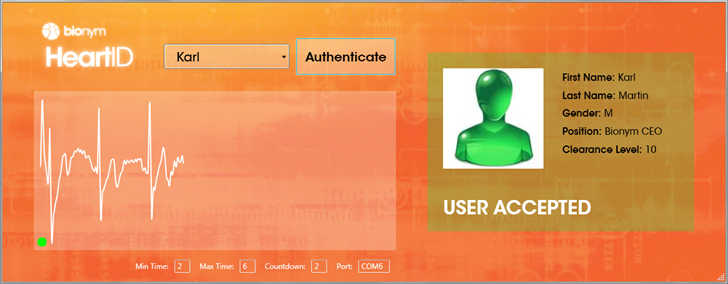Logging In with Your Heartbeat

Smartphones, tablets, gaming consoles and other devices may soon recognize their owners at a touch. The gadgets will identify users by measuring their heartbeats through their fingertips.
"ECG biometrics identifies people by their cardiac rhythm," said Foteini Agrafioti, an engineer at the University of Toronto who developed a version of the technology and started a company, Bionym, to market it. "Not just their heart rate, but the actual shape of their heartbeat."
Such a heartbeat ID, embedded into a phone or tablet, could lock out unauthorized users or bring up individuals' saved preferences on a shared device, say researchers who study the technology. Heartbeats could be a secure alternative — or supplement — to more established biological ID measures, such as fingerprints. And unlike some futuristic identification schemes, heartbeat IDs are technologically ready to go.
Whether the tech takes off now depends on whether customers will take to getting identified by their hearts.
The unique shape of your heart
When pictured in a graph called an electrocardiogram (ECG), human heartbeats all share the same general shape, each beat represented by the up-and-down spike familiar from medical dramas.
For generations, doctors measured that spike by sticking sensors on people's chests. Recently, however, researchers have developed cheap, thin sensors that are able to measure ECGs through the fingertips. People just need to touch the sensors for a few seconds, using one finger from each hand. The finger sensors have made it possible to embed heartbeat measurements into smartphones and other devices, although they aren't precise enough for doctors' diagnoses. [Wearable Electronics Pave Way for Smart Surgeon Gloves]
Get the world’s most fascinating discoveries delivered straight to your inbox.
Meanwhile, engineers have found that the exact shape of ECG spikes varies from person to person. Everyone has his or her own unique shape, which remains even during heart rate changes caused by excitement or exercise. That shape also stays the same over time.
Different ECG-analyzing computer programs have slightly different accuracy rates, but in general, they're accurate enough to work as ID systems on their own, Agrafioti said. The Bionym website suggests using its "HeartID" for the military and police officers.
Ana Fred, an engineer at the Technical University of Lisbon in Portugal also researching this technology, doesn't agree ECGs are ready for higher-security uses. Fingerprinting is still more accurate, she said. However, it should be possible to bring heartbeat analysis up to par by combining different analysis techniques, which Fred is studying. "In the end, I think we will be able to use it as a standalone," she said.
Heartbeats for backup
If airports or other high-security locations don't want to depend on heartbeats alone, they can combine ECG measurements with other ID checks, such as fingerprint scanners, said Adrian Chan, an engineer at Carleton University in Canada who has built ECG ID systems. An ECG sensor could go right into a fingerprint scanner, boosting the scanner's accuracy.
The sensor would also ensure the person making the print is alive. "You watch any type of spy movie or anything like that, and people just chop off your finger" to get through a fingerprint scanner, Chan said. He also pointed to a study from 2010 in which researchers fooled a fingerprint scanner by lifting an authorized person's fingerprints off the scanner's surface and making gelatin fingers to match.
Researchers interviewed by TechNewsDaily weren't sure how often such spoofing happens in real life, but agreed that heartbeat sensors would make such tricks much more difficult. "In my opinion, it offers airtight security," Agrafioti said. "[Your heartbeat] is hidden in your body. It's impossible for someone to steal it from you."
A heart-activated key
In less critical situations, all the researchers agreed heartbeat ID would work well on its own. Agrafioti has created a key card that users activate by holding it for a few seconds with both hands. Such a card couldn't be made to recognize other biological characteristics, such as fingerprints or faces, because those biometrics require too much processing power, she said.
ECGs could pull up users' accounts on a shared computer, video-game console or stair-stepper at the gym, Fred said. Those machines could then automatically go to the user's preferred settings, saved game or workout difficulty. [Futuristic Security Schemes Could Kill Passwords]
"Any device you hold with both hands, such as an iPad or smartphone, can all very much do ECG recognition," Agrafioti said.
Ready for market
Heartbeat sensors are technically ready for market, Agrafioti, Chan and Fred all say. Agrafioti's Bionym is looking for commercial partners now, with engineers waiting to see if the technology takes off among consumers.
ECG's success depends on whether people feel it's easy to use, Chan thinks. "The user wants to have a certain feeling of security, but not at the cost of their convenience," he said. Fingerprint sensors are also commercially available, but aren't common in consumer products like laptops, he added.
For Agrafioti, it's a question of telling people about the technology. "You have to get it out there. It's a new idea. People have to see it first before they can trust it," she said. "I believe that once it's out there, it really solves a lot of problems that we have today with other biometric systems."
This story is part of a series about exotic biometrics — unexpected ways that researchers are working on to identify people by their biological features. "It is important to keep track of the new/unusual/not-yet-much-studied things, because this is where the next big things come from," Kevin Bowyer, chair of the computer science and engineering department at the University of Notre Dame, told TechNewsDaily. "Of course, most exotic things never become big. But history says that some will."
Bowyer served as a reviewer for a biometrics conference held Sept. 24 through Sept. 26. He helped choose some of the research we'll examine in this series, which will not feature his own work.
His own area of expertise, iris scanning, was considered exotic 20 years ago, he added.
You can follow TechNewsDaily staff writer Francie Diep on Twitter @franciediep. Follow TechNewsDaily on Twitter @TechNewsDaily, or on Facebook.


